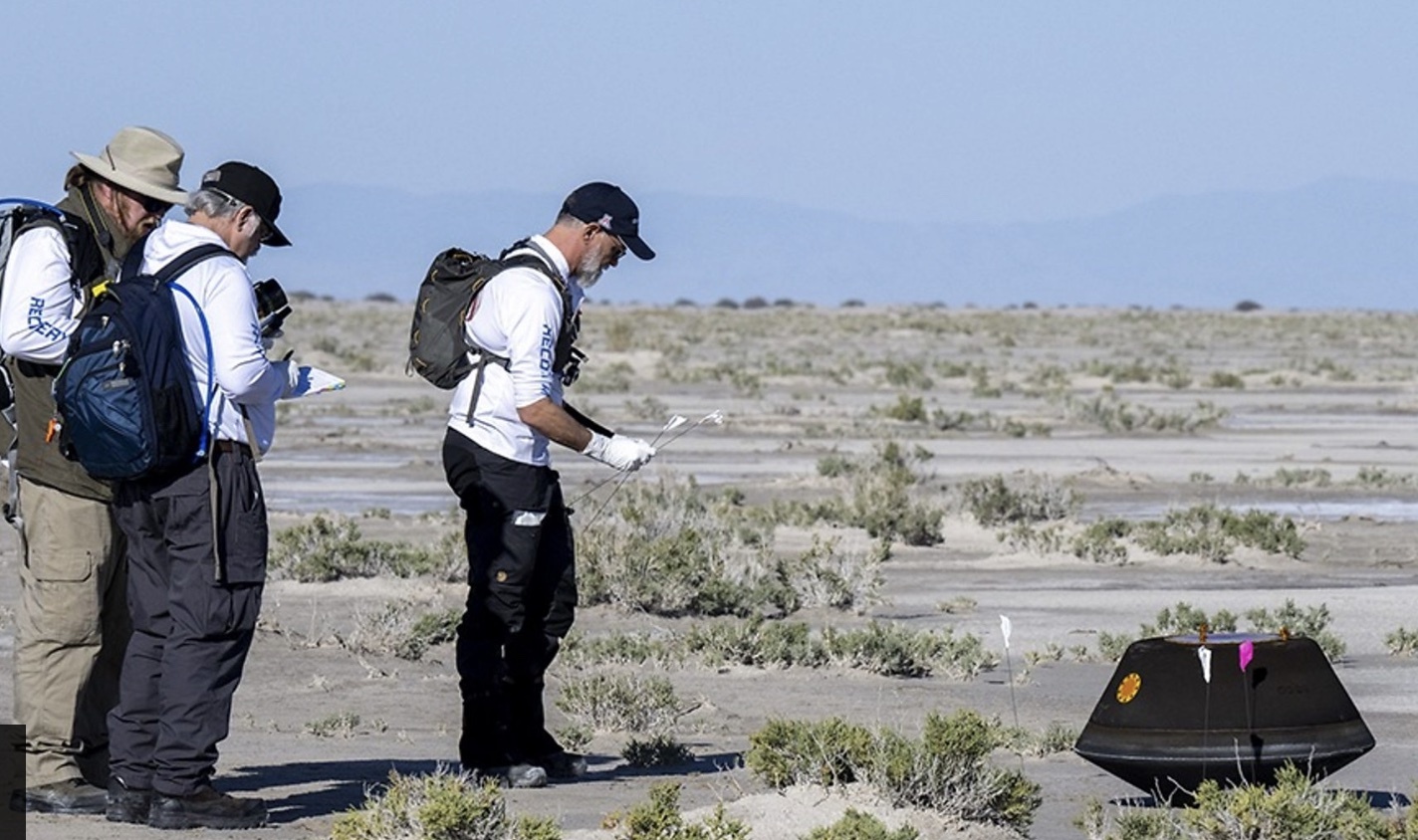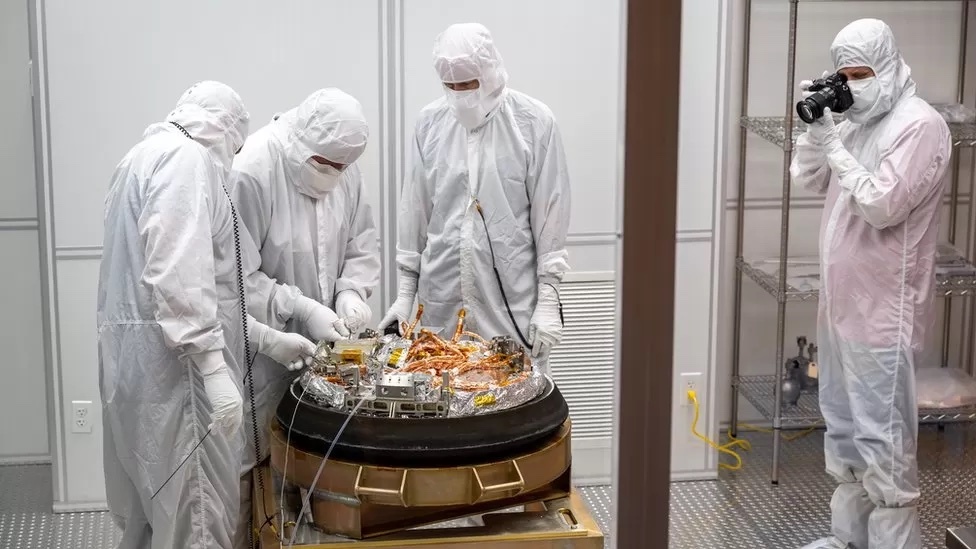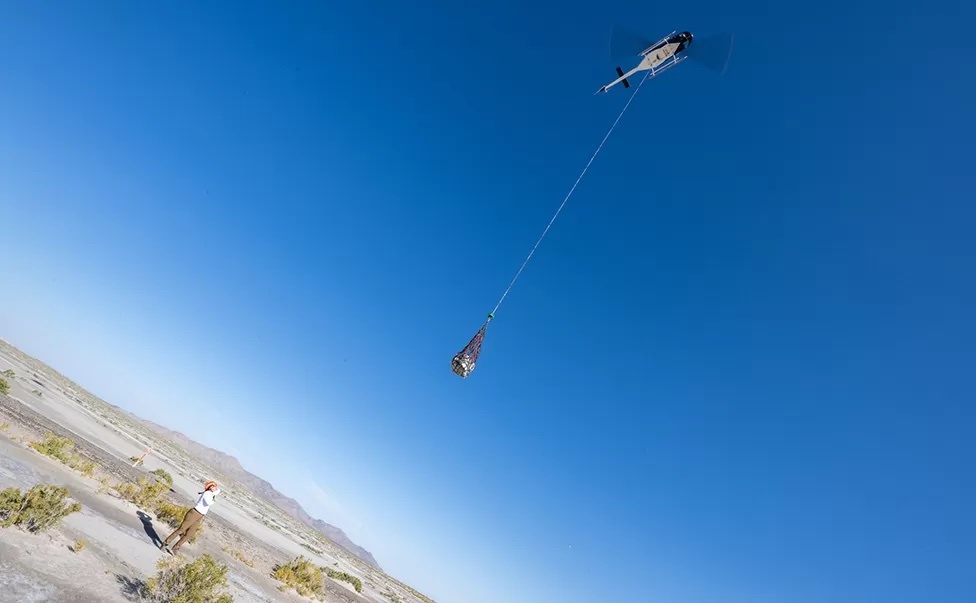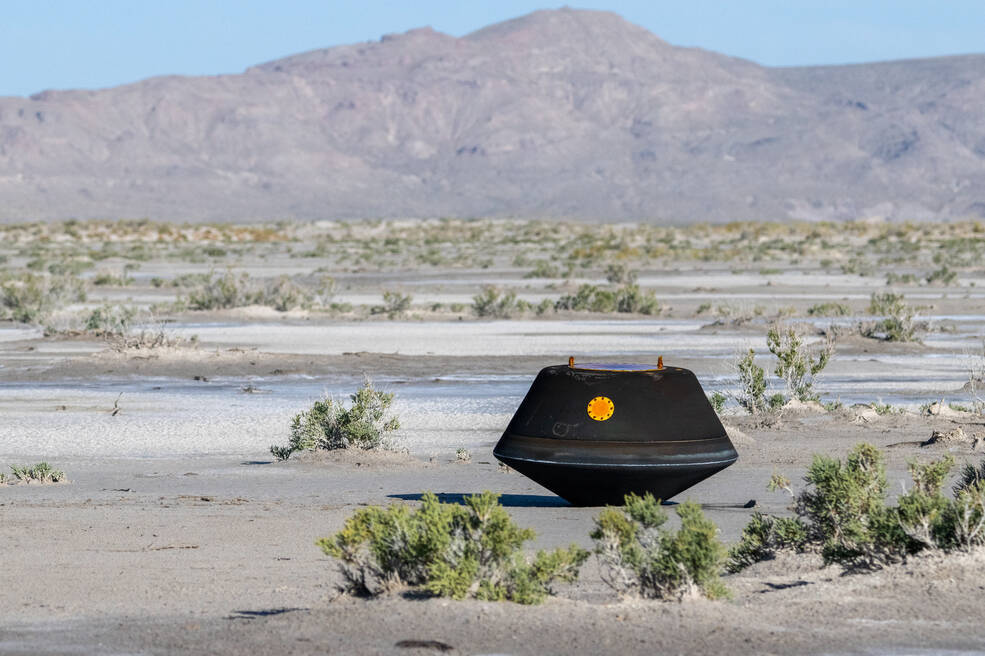26.09.2023
Osiris-Rex: Nasa confirms return of asteroid Bennu samples

Dusty samples from the "most dangerous known rock in the Solar System" have been brought to Earth.
The American space agency Nasa landed the materials in a capsule that came down in the West Desert of Utah state.
The samples had been scooped up from the surface of asteroid Bennu in 2020 by the Osiris-Rex spacecraft.
Nasa wants to learn more about the mountainous object, not least because it has an outside chance of hitting our planet in the next 300 years.
But more than this, the samples are likely to provide fresh insights into the formation of the Solar System 4.6 billion years ago and possibly even how life got started on our world.
There was jubilation when the Osiris-Rex team caught sight of their capsule on long-range cameras.

Components such as the heatshield and back cover were removed in the temporary clean room
Touchdown on desert land belonging to the Department of Defense was confirmed at 08:52 local time (14:52 GMT), three minutes ahead of schedule.
The car-tyre-sized container had come screaming into the atmosphere over the western US at more than 12km/s (27,000mph). A heatshield and parachutes slowed its descent and dropped it gently, perfectly on to restricted ground.
"This little capsule understood the assignment," said Tim Priser, the chief engineer at aerospace manufacturer Lockheed Martin. "It touched down like a feather."
Asked how the operation went to retrieve the capsule from the desert, some of the recovery workers returning in their helicopters told BBC News' science team that it was "awesome".
"I cried like a baby in that helicopter when I heard that the parachute had opened and we were coming in for a soft landing," said Osiris-Rex principal investigator Dante Lauretta.
"It was just an overwhelming moment for me. It's an astounding accomplishment."
Scientists are eager to get their hands on the precious cargo which pre-landing estimates put at some 250 grams (9oz).
That might not sound like very much - the weight of an adult hamster, as one scientist described it - but for the types of tests Nasa teams want to do, it is more than ample.
"We can analyse at a very high resolution very small particles," said Eileen Stansbery, the chief scientist at Nasa's Johnson Space Center in Texas.
"We know how to slice and dice a 10 micron-sized particle into a dozen slices and to then map grain by grain at nano scales. So, 250 grams is huge."

Helicopters were sent out to retrieve the landed capsule
Cleanliness was the watchword out in the desert. When the recovery teams caught up with the capsule on the ground, their motivation was to bring it back to a temporary clean room at the nearby Dugway army base as quickly as possible.
If, as researchers think, the sample contains carbon compounds that may have been involved in the creation of life then mixing the rocky material with present-day Earth chemistry has to be avoided.
"The cleanliness and preventing contamination of the spacecraft has been a really stringent requirement on the mission," said Mike Morrow, the Osiris-Rex deputy project manager.
"The best way that we can protect the sample is just to get it from the field into the clean lab that we've set up here in a hangar as quickly as possible and get it under a pure nitrogen gas purge. And then it's safe."
This was achieved just before 13:00 local time, a mere four hours after touchdown.
The lab team disassembled the capsule, removing its heatshield and back cover but leaving the sample secure inside an inner canister.
This is being flown on Monday to a dedicated facility at Johnson where the analysis of the samples will begin.
UK scientist Ashley King will be part of a six-person "Quick Look" team that will conduct the initial assessment.
"I'm expecting to see a rocky type material that's very soft, very fragile," the Natural History Museum expert said.
"It'll have clay minerals - silicate minerals that have water locked up in their structure. Lots of carbon, so I think we'll probably see carbonate minerals, and maybe some things we call chondrules and also calcium-aluminium inclusions, which were the very first solid materials to form in our Solar System."
Nasa is planning a press conference on 11 October to give its first take on what has been returned. Small specimens are to be distributed to associated research teams across the globe. They hope to report back on a broad range of studies within two years.
"One of the most important parts of a sample-return mission is we take 75% of that sample and we're going to lock it away for future generations, for people who haven't even been born yet to work in laboratories that don't exist today, using instrumentation we haven't even thought of yet," Nasa's director of planetary science, Lori Glaze, told BBC News.
Quelle: BBC
+++
NASA’s First Asteroid Sample Has Landed, Now Secure in Clean Room

After years of anticipation and hard work by NASA’s OSIRIS-REx (Origins, Spectral Interpretation, Resource Identification and Security – Regolith Explorer) team, a capsule of rocks and dust collected from asteroid Bennu finally is on Earth. It landed at 8:52 a.m. MDT (10:52 a.m. EDT) on Sunday, in a targeted area of the Department of Defense’s Utah Test and Training Range near Salt Lake City.
Within an hour and a half, the capsule was transported by helicopter to a temporary clean room set up in a hangar on the training range, where it now is connected to a continuous flow of nitrogen.
Getting the sample under a “nitrogen purge,” as scientists call it, was one of the OSIRIS-REx team’s most critical tasks today. Nitrogen is a gas that doesn’t interact with most other chemicals, and a continuous flow of it into the sample container inside the capsule will keep out earthly contaminants to leave the sample pure for scientific analyses.
The returned samples collected from Bennu will help scientists worldwide make discoveries to better understand planet formation and the origin of organics and water that led to life on Earth, as well as benefit all of humanity by learning more about potentially hazardous asteroids.
“Congratulations to the OSIRIS-REx team on a picture-perfect mission – the first American asteroid sample return in history – which will deepen our understanding of the origin of our solar system and its formation. Not to mention, Bennu is a potentially hazardous asteroid, and what we learn from the sample will help us better understand the types of asteroids that could come our way,” said NASA Administrator Bill Nelson. “With OSIRIS-REx, Psyche launch in a couple of weeks, DART’s one year anniversary, and Lucy’s first asteroid approach in November, Asteroid Autumn is in full swing. These missions prove once again that NASA does big things. Things that inspire us and unite us. Things that show nothing is beyond our reach when we work together.”
The Bennu sample – an estimated 8.8 ounces, or 250 grams – will be transported in its unopened canister by aircraft to NASA’s Johnson Space Center in Houston on Monday, Sept. 25. Curation scientists there will disassemble the canister, extract and weigh the sample, create an inventory of the rocks and dust, and, over time, distribute pieces of Bennu to scientists worldwide.
Today’s delivery of an asteroid sample – a first for the U.S. – went according to plan thanks to the massive effort of hundreds of people who remotely directed the spacecraft’s journey since it launched on Sept. 8, 2016. The team then guided it to arrival at Bennu on Dec. 3, 2018, through the search for a safe sample-collection site between 2019 and 2020, sample collection on Oct. 20, 2020, and during the return trip home starting on May 10, 2021.
“Today marks an extraordinary milestone not just for the OSIRIS-REx team but for science as a whole,” said Dante Lauretta, principal investigator for OSIRIS-REx at the University of Arizona, Tucson. “Successfully delivering samples from Bennu to Earth is a triumph of collaborative ingenuity and a testament to what we can accomplish when we unite with a common purpose. But let’s not forget – while this may feel like the end of an incredible chapter, it’s truly just the beginning of another. We now have the unprecedented opportunity to analyze these samples and delve deeper into the secrets of our solar system."
After traveling billions of miles to Bennu and back, the OSIRIS-REx spacecraft released its sample capsule toward Earth’s atmosphere at 6:42 a.m. EDT (4:42 a.m. MDT). The spacecraft was 63,000 miles (102,000 kilometers) from Earth’s surface at the time – about one-third the distance from Earth to the Moon.
Traveling at 27,650 mph (44,500 kph), the capsule pierced the atmosphere at 10:42 a.m. EDT (8:42 a.m. MDT), off the coast of California at an altitude of about 83 miles (133 kilometers). Within 10 minutes, it landed on the military range. Along the way, two parachutes successfully deployed to stabilize and slow the capsule down to a gentle 11 mph (18 kph) at touchdown.
“The whole team had butterflies today, but that’s the focused anticipation of a critical event by a well-prepared team,” said Rich Burns, project manager for OSIRIS-REx at NASA’s Goddard Space Flight Center in Greenbelt, Maryland. “For us, this was the World Series, ninth inning, bases-loaded moment, and this team knocked it out of the park.”
Radar, infrared, and optical instruments in the air and on the ground tracked the capsule to its landing coordinates inside a 36-mile by 8.5-mile (58-kilometer by 14-kilometer) area on the range. Within several minutes, the recovery team was dispatched to the capsule’s location to inspect and retrieve it. The team found the capsule in good shape at 9:07 a.m. MDT (11:07 a.m. EDT) and then determined it was safe to approach. Within 70 minutes, they wrapped it up for safe transport to a temporary clean room on the range, where it remains under continuous supervision and a nitrogen purge.
NASA Goddard provides overall mission management, systems engineering, and the safety and mission assurance for OSIRIS-REx. The University of Arizona, Tucson leads the science team and the mission's science observation planning and data processing. Lockheed Martin Space in Littleton, Colorado, built the spacecraft and provides flight operations. Goddard and KinetX Aerospace are responsible for navigating the OSIRIS-REx spacecraft. Curation for OSIRIS-REx, including processing the sample when it arrives on Earth, will take place at NASA Johnson. International partnerships on this mission include the OSIRIS-REx Laser Altimeter instrument from CSA (the Canadian Space Agency) and asteroid sample science collaboration with JAXA’s (the Japan Aerospace Exploration Agency) Hayabusa2 mission. OSIRIS-REx is the third mission in NASA’s New Frontiers Program, managed by NASA’s Marshall Space Flight Center in Huntsville, Alabama, for the agency’s Science Mission Directorate in Washington.
Quelle: NASA

